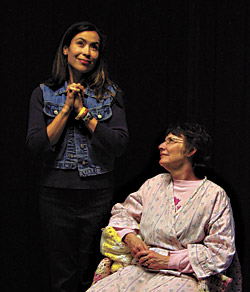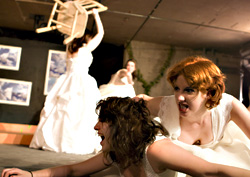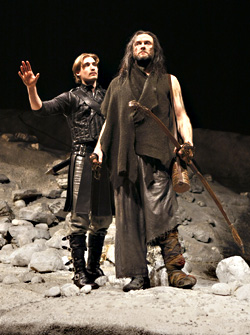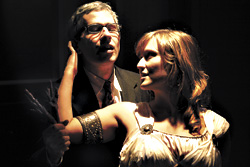The Incredibles used to have it all: fame, superpowers, trim waists, the works. Now all they’ve got is love and the sort of drab suburban life where only Steven Spielberg could find a little magic. James Joyce had a word for it: “muddlecrass.” In their prime, Bob, aka Mr. Incredible (voiced by Craig T. Nelson), would thwart multiple robbers and hell-bound trains en route to a wedding without mussing his tux or his superduds. Wife Helen (Holly Hunter), trade name Elastigirl, saved lives with the longest arms the law ever saw.
But when people rescued from falls started suing for whiplash and cities started billing for collateral infrastructure damage, fickle public opinion turned against the heroes, as we learn in Brad Bird’s The Incredibles, which opens Friday, Nov. 5, at the Metro and other theaters. The state forced them to adopt permanent secret identities, relocate via the Supers Protection Program, and swear off do-goodery for good.
Fifteen years later, Mr. Incredible is an insurance adjuster confined to a jail-cell-like cubicle. When he defies his nemesis, a spluttering homunculus boss (Wallace Shawn), he loses every time. Meanwhile, Mrs. Incredible looks after teen daughter Violet (NPR’s nasally, quavery Sarah Vowell), who resembles Wednesday of the Addams Family; hyperactive preteen Dash (Spencer Fox); and preverbal baby Jack-Jack. Helen’s extensible arms prove incredibly handy in mediating the kids’ dinner-table battles, but that’s about it for crime busting. Pathetically, some nights Mr. I. tells the missus he’s bowling with recovering superpal Frozone (Samuel L. Jackson) when they’re actually monitoring the police radio to nab bad guys on the sly.
The ads for Pixar’s triumphant new CG animation insta-classic can only suggest the brilliance of the slapstick comedy involved in Mr. I’s midlife crisis—squeezing his swollen belly into tight places and such. In fact, writer-director Bird (The Iron Giant) makes his plight far more poignant. This isn’t just a cartoon, it tops any live-action feature at the multiplex for honest emotion, snappy dialogue, character integrity, and the lost art of narrative coherency.
And when the Incredibles get recruited out of retirement to battle embittered mad scientist Buddy Pine (Jason Lee) on his sinister island, the action is infinitely more kinetic than almost any kaboom movie in recent memory, and not far inferior to Spider-Man. The runaway- commuter-train scene doesn’t lose that much in the translation from CG-assisted live action to next-wave CG animation. The aerial duels and zippy gizmos on the bad guy’s isle—manta jet/subs, velocipods, an Omnidroid like the Tolkien spider with Doc Ock’s arms—pack some Lucas punch without the impersonal, ponderous portentousness. The family-that-saves-together-stays-together theme comes across better than in Spy Kids, with giggles but no smirks.
Save for the soulful Finding Nemo, The Incredibles beats any animated feature in recent memory. It makes Shrek’s two adventures and Shark Tale look like formless explosions in a pop-allusion factory, and it’s the first animated feature with the cram-packed alertness of The Simpsons, Bird’s ex-employer. Like a Pollock canvas, it wastes no space; each moment crackles with intelligence. The advances aren’t merely technical but aesthetic. Faces boast subtler expressions than ever, simulating not the human face but a particular human: Holly Hunter is seldom this good an actress when she’s working with her whole body. Fabrics move more realistically—and costume gets infused with character. The film’s sprightliest figure, the Edith Head–esque designer Edna Mode (superbly voiced by Bird), gives a quickie history of superhero capes that pokes fun at the funnies, expresses personality, and propels the clockwork plot.
Comic-fan nerds are concerned that the Incredibles rip off Marvel’s Fantastic Four, which is now being processed through Hollywood’s comic-book recycling factory. True, Mr. I. is like Mr. Fantastic (Reed Richards) with Superman’s muscle. Elastigirl has Reed’s flexibility and capacity to become a parachute, while her shrinking daughter, Violet, gets Mrs. Fantastic’s oh-so-feminine powers of invisibility and force-field projection. Son Dash has the Human Torch’s excitable personality with the Flash’s supersprinting ability.
So what? Mr. Fantastic wasn’t the first Plastic Man in the comics universe. The point is not the superpower but the power of the character. The Incredibles make the Fantastic Four look flat and derivative (Marvel was only reprising existing character types from other comics, movies, and radio serials). And they’re rounded by character as well as technology. Violet’s and Dash’s development of their powers perfectly expresses everybody’s adolescent experience of self-discovery. It’s not just a repeat of the Flash’s or the FF’s acts. What makes the Incredibles great is that they tap the ultimate power: the secret of one’s own identity, individual and familial.







